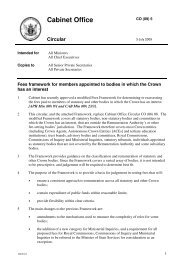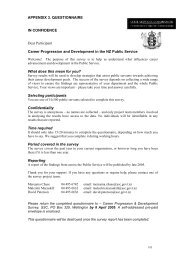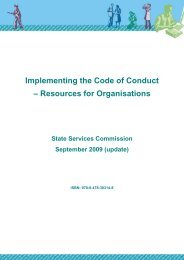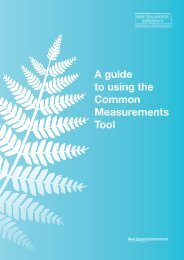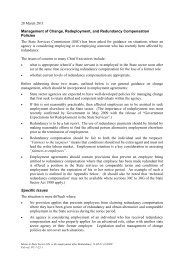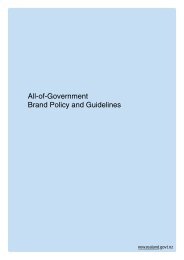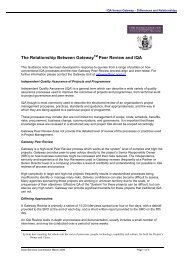Better Public Services Advisory Group Report - November 2011
Better Public Services Advisory Group Report - November 2011
Better Public Services Advisory Group Report - November 2011
You also want an ePaper? Increase the reach of your titles
YUMPU automatically turns print PDFs into web optimized ePapers that Google loves.
seconded into them and potentially their own appropriations. Whereas joint working<br />
groups typically tend to involve only 10 to 20 staff, joint ventures could be significantly<br />
bigger, incorporating both policy and operational capability.<br />
• Executive agencies: As a new organisational form – to help avoid having either few<br />
large, multi-functional departments or many small agencies. Executive agencies<br />
would make most sense in relatively well-defined sectors with a clear lead Ministry<br />
and a desire to coordinate investment decisions as well as policy direction. These<br />
agencies would sit within the Crown (so are closer to Ministers than Crown entities),<br />
under the leadership of a larger department, but held to account for their own<br />
operational responsibilities. They would work to the strategy, policy and funding<br />
arrangements determined by the lead agency.<br />
3.14 Examples of where these arrangements might be used are provided below.<br />
3.15 Overall, and on balance, the <strong>Advisory</strong> <strong>Group</strong> considers that New Zealand is not well<br />
served by the high number of departments in the state services, particularly where there<br />
is a lot of overlap and duplication between separate agencies’ briefs.<br />
3.16 Similarly, the <strong>Advisory</strong> <strong>Group</strong> is not convinced efficient government is best served by the<br />
proliferation of Crown entities that currently exist. Not only do extra entities require extra<br />
back-office support, but the presence of an independent board can be confusing to<br />
stakeholders and unhelpful for ensuring coordinated action to achieve better results.<br />
Where independent functions that need protecting exist, this can often be done within the<br />
departmental framework, 21 or potentially by using the new executive agency form<br />
proposed in this report.<br />
3.17 Determining the right organisational form needs to take account of factors such as scope<br />
of activities, critical mass and economies of scale as well as the impact on results. A<br />
degree of lateral thinking may often be required. In some cases regional and/or local<br />
government play a critical role in delivering results (eg, in transport or fresh water<br />
management), as do non-government organisations or firms. The Treasury and the State<br />
<strong>Services</strong> Commission need to ensure the interpretation or letter of the foundational<br />
pieces of legislation that govern the state services (<strong>Public</strong> Finance Act 1989, State Sector<br />
Act 1988 and Crown Entities Act 2004) do not impose unnecessary constraints on<br />
different parties working together.<br />
3.18 The <strong>Advisory</strong> <strong>Group</strong> also considers that further flexibility in the way agencies organise<br />
themselves to deliver results would be useful. In particular, to better organise policy<br />
resources, and to move resources to where they can make the most difference:<br />
21 For example, until recently the independent allocation of research funding was protected in a Crown entity, The<br />
Foundation for Research, Science and Technology, separate from the Ministry of Research, Science and<br />
Technology. Now this independence is protected by a statutorily independent allocation function within the Ministry<br />
of Science and Innovation: science and innovation advice is better informed as a result, with less bureaucratic churn<br />
between agencies.<br />
27







